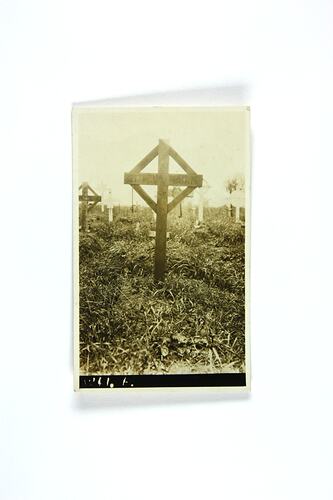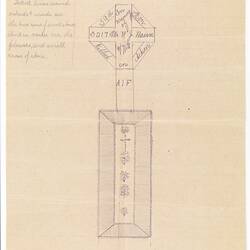Summary
Postcard with image of the grave of Private William Nairn, who was killed in France on 4 July 1918, during World War I. A sketch of William's grave was also donated with the collection (HT 42547). It provides a clearer indication of the inscriptions on his cross: '59th Btn 3217 Pte. W. J. Nairn 4/7/18 Killed in Action A.I.F.'
William's place of death is variously recorded as Hamel (Roll of Honour), Villers-Bretonneux and Ville or Villiers sur Ancre (fellow soldiers). His date of death coincides with the Battle of Hamel, which was commanded and led by John Monash and included William's 59th Battalion. William was buried by Rev. L.S. Couston at Vignacourt Military Cemetery, France.
Individual photographs of graves - often described as 'sacred' places - were sought by countless relatives as a way of connecting them with loved ones who had died in battle. They were provided by visitors or, more often, the Directorate of Graves Registration and Enquiries. Soon after World War I ended an Australian photographic section was established to undertake the task in a systematic manner. These early photographs typically depicted temporary wooden crosses erected over graves. In the 1920s the Imperial (later Commonwealth) War Graves Commission undertook the enormous task of re-burials into defined and ordered cemeteries, using standard headstones. William Nairn's burial site was changed to Mericourt L'Abbe Military Cemetery.
Description of Content
Cross in graveyard. The cross appears to be made from brown wood, with interconnecting diagonals, similar to those seen in the background. Some other graves visible are painted white, with circular form around the cross. The main cross has words painted upon it: '3217 PTE W. J. NAIRN.' (remainder illegible) The ground of the graveyard has long, uncut grass, although a depression for the grave can still be seen, suggesting it is relatively recent.
Physical Description
Black and white photograph on postcard proforma.
More Information
-
Collecting Areas
-
Date Inscribed
-
Place Depicted
-
Person Commemorated
Private William (Bill) J. Nairn - Australian Imperial Force (AIF)
-
Format
Print, Black & White
-
Inscriptions
On grave cross: '3217 PTE W. J. NAIRN.' [remainder illegible]' [Illegible inscription below image] Back of postcard, printed: 'POST CARD / CARTE POSTALE / Communication-Correspondance / Address-Addresse / STAMP / HERE'. Logo: 'K/LTD'. Back of postcard, hand-written: '26.3.20'. Over stamp: 'W61-6'.
-
Classification
-
Category
-
Discipline
-
Type of item
-
Dimensions
88 mm (Width), 135 mm (Height)
-
References
NAIRN, William John - National Archives of Australia, barcode 7989771 First World War Red Cross Wounded and Missing files, William John Nairn, Australian War Memorial Family Notices. (1917, January 8). Geelong Advertiser (Vic. : 1859 - 1924), p. 1. Retrieved June 2, 2015, from [Link 1] Classified Advertising. (1920, November 17). The Argus (Melbourne, Vic. : 1848 - 1957), p. 16. Retrieved June 23, 2015, from [Link 2] Bart Ziino, A Distant Grief: Australians, War Graves and the Great War. University of WA Press, 2007
-
Keywords
World War I, 1914-1918, Military Memorabilia, Death & Mourning, Graves




